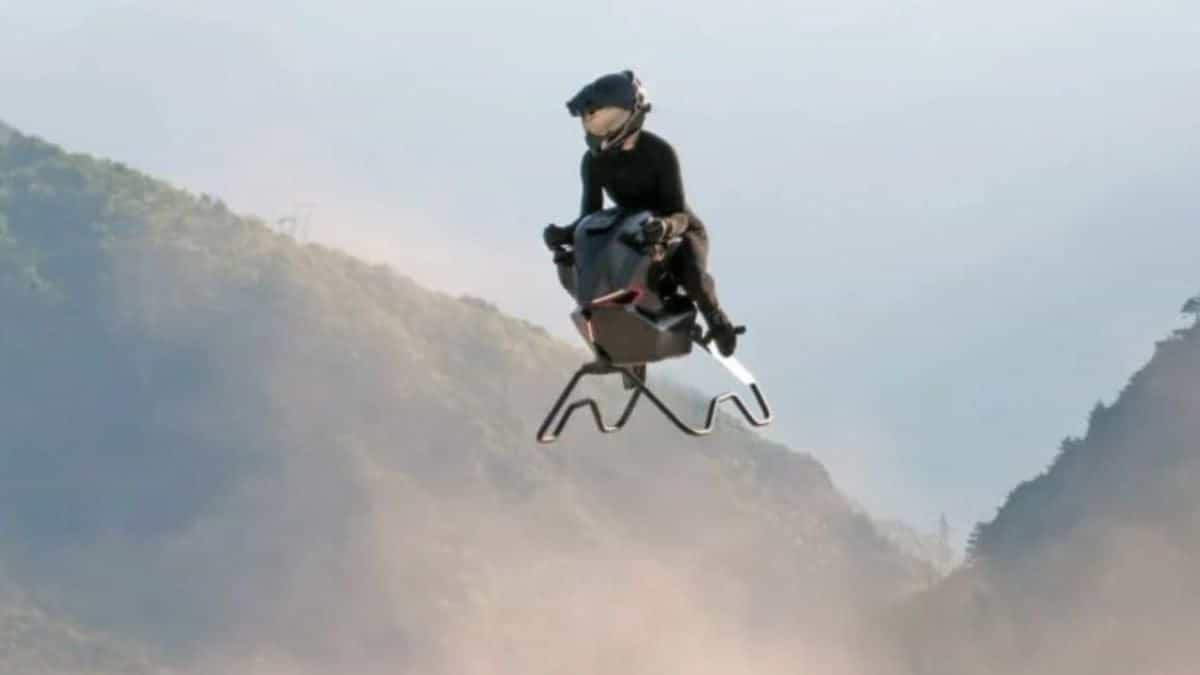Show table of content Hide table of content
The world of transportation is witnessing a revolutionary leap forward with the introduction of a flying motorcycle capable of reaching speeds up to 200 km/h. Polish company Volonaut has unveiled their groundbreaking “Airbike,” a single-seater aerial vehicle that promises to transform our daily commutes. This innovation marks a significant milestone in urban aerial mobility, bringing science fiction concepts from Star Wars into our reality.
Revolutionary flying motorcycle technology takes flight
The Airbike represents a significant breakthrough in personal transportation technology. Developed by Polish company Volonaut, this flying motorcycle combines cutting-edge engineering with futuristic design principles. Unlike conventional motorcycles, the Airbike utilizes jet propulsion systems that allow it to soar through the air with remarkable stability and control.
What makes this flying vehicle particularly impressive is its construction. Manufactured using carbon fiber and 3D-printed components, the Airbike weighs seven times less than traditional motorcycles. This lightweight design enhances its maneuverability while reducing energy consumption. The engineering team at Volonaut has prioritized both performance and practicality in its development.
News This TikToker buys a used van and realizes it has a hidden surveillance device.
The Airbike’s advanced flight computer assists pilots in controlling the vehicle even at high speeds. This technological innovation makes aerial transportation accessible to individuals without extensive pilot training. Similar to how modern software systems enhance user experience, the Airbike’s computer system simplifies the flying process while maintaining safety standards.
With a panoramic 360-degree view, riders enjoy an immersive aerial experience unlike anything available in today’s transportation options. This design feature not only improves visibility for safety purposes but also transforms each journey into an exhilarating adventure. The Airbike represents the perfect marriage between practical transportation and recreational experience.
From science fiction to market reality
The Airbike’s journey from concept to reality illustrates how science fiction continues to inspire real-world innovations. Creator Tomasz Patan, an entrepreneur and inventor, transformed his passion for futuristic transportation depicted in films like Star Wars into a tangible product. His determination echoes other visionaries who brought seemingly impossible technologies to life.
Priced at €106,000, the Airbike positions itself as a premium transportation option. While this price point places it beyond casual consumers, it compares favorably to other pioneering transportation technologies. Early adopters of revolutionary products often pay premium prices, similar to how Steve Jobs’ innovations commanded premium prices before becoming mainstream.
The Airbike’s development reflects broader trends in transportation innovation. As urban congestion increases, companies are looking skyward for solutions. Flying vehicles offer a means to bypass ground-level traffic entirely. While some entrepreneurs focus on electric aerial vehicles, Volonaut’s jet propulsion approach provides distinct advantages in speed and range.
Beyond transportation, flying motorcycles could revolutionize other sectors. Emergency services might utilize such vehicles for rapid response in congested areas. Tourism opportunities could emerge, offering aerial tours of scenic locations. Some enthusiasts have already begun exploring how such technology might transform recreational activities, much like how adventurers seek unique experiences in extreme environments.
Performance specifications that defy expectations
The Airbike’s capabilities push the boundaries of personal transportation. With a maximum speed of 200 km/h, this flying motorcycle outpaces many conventional vehicles. This impressive velocity transforms lengthy commutes into brief journeys, potentially saving hours of travel time daily.
Range remains a consideration for any alternative transportation solution. The Airbike can travel approximately 40 kilometers on a single charge, making it suitable for urban commuting and short-distance travel. Specialized charging stations support the vehicle’s power requirements, creating a new infrastructure network for aerial mobility.
News Bat wings after 50? Here’s the most effective exercise, according to a coach.
The compact design allows the Airbike to navigate tight spaces with ease, offering advantages over larger flying vehicles. This maneuverability proves particularly valuable in urban environments where space comes at a premium. Creative engineering solutions enable this compact profile without sacrificing stability or performance, similar to how innovative thinking transformed an old typewriter into a gaming PC.
Safety features incorporate redundant systems to ensure reliable operation. While specific safety protocols weren’t detailed in Volonaut’s initial announcement, industry standards for aerial vehicles typically include emergency landing capabilities and stability controls. As with any new transportation technology, regulatory frameworks will likely evolve alongside the technology.
The future of personal aerial transportation
The Airbike represents just the beginning of a potential aerial transportation revolution. As technology advances and production scales, we might expect prices to decrease and capabilities to expand. Future iterations could feature extended range, enhanced safety systems, and greater automation.
Consumer adoption will depend on regulatory frameworks as much as technological capability. Different countries will likely develop varying approaches to licensing and airspace management for personal flying vehicles. Some nations may embrace these innovations quickly, while others might proceed more cautiously.
Environmental considerations will influence development trajectories. While current models rely on traditional propulsion methods, future versions might incorporate cleaner energy sources. The environmental impact of widespread adoption remains a subject for ongoing assessment, similar to how long-term effects of lifestyle choices require careful study.
Potential competitors are already emerging in the flying vehicle market. Various approaches include multi-rotor designs, fixed-wing hybrids, and other novel configurations. This competitive landscape will likely accelerate innovation while driving down costs, benefiting consumers seeking alternatives to conventional transportation. However, consumers should remain vigilant about market claims, as some companies may overpromise capabilities, similar to how technology scams can mislead unwary buyers.
The introduction of flying motorcycles like the Airbike may inspire entirely new transportation paradigms. Urban planning could evolve to accommodate aerial commuting routes, while social norms around travel might shift dramatically. The rise of aerial vehicles could parallel how unique innovations can transform established industries, creating entirely new categories of experience and utility.


